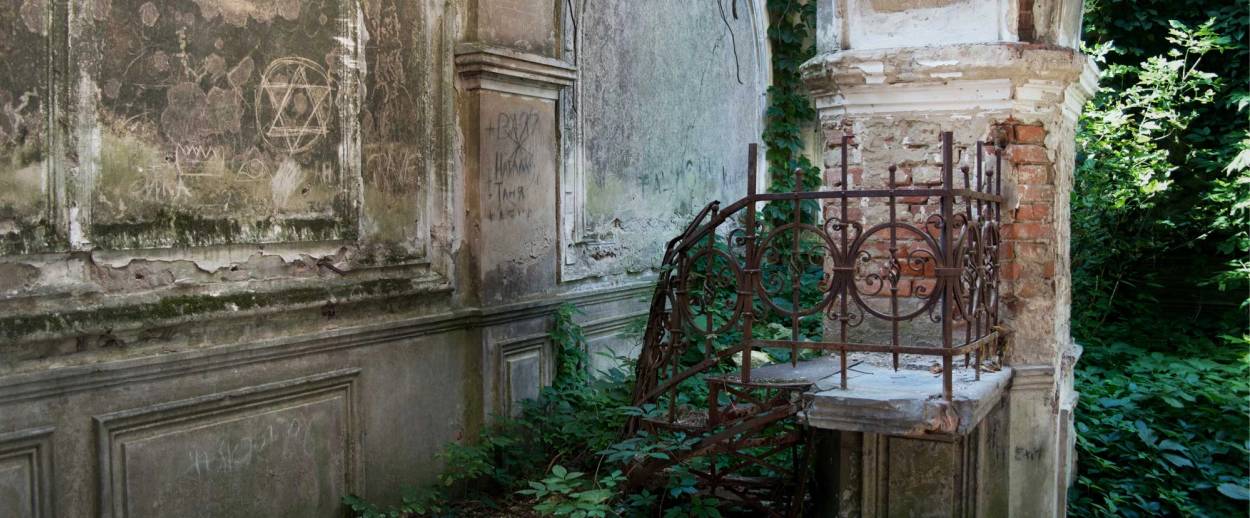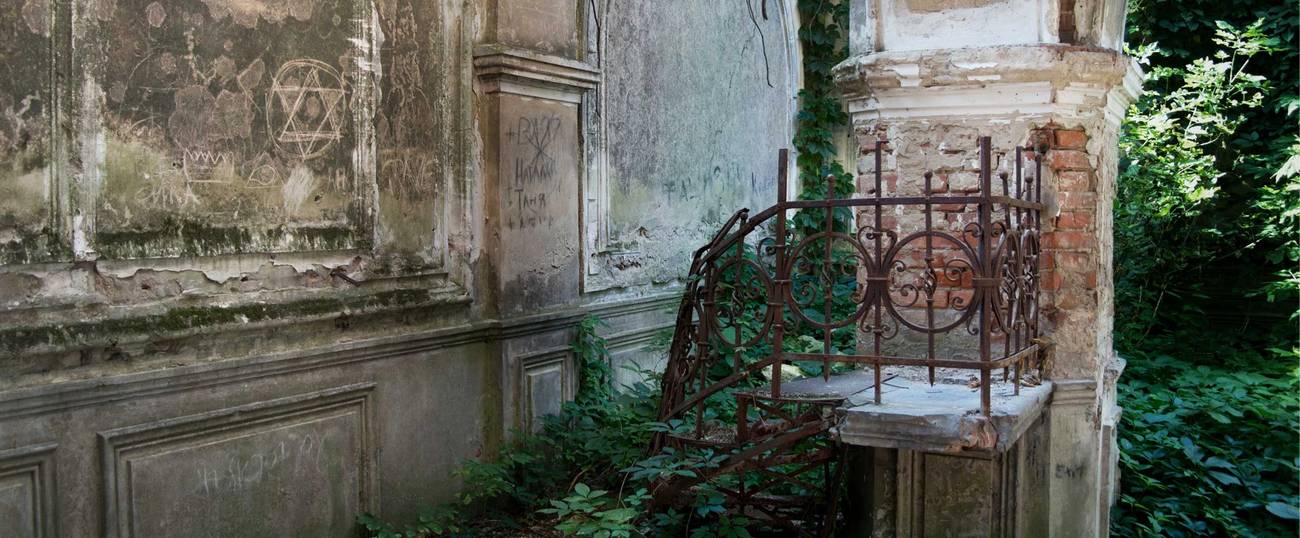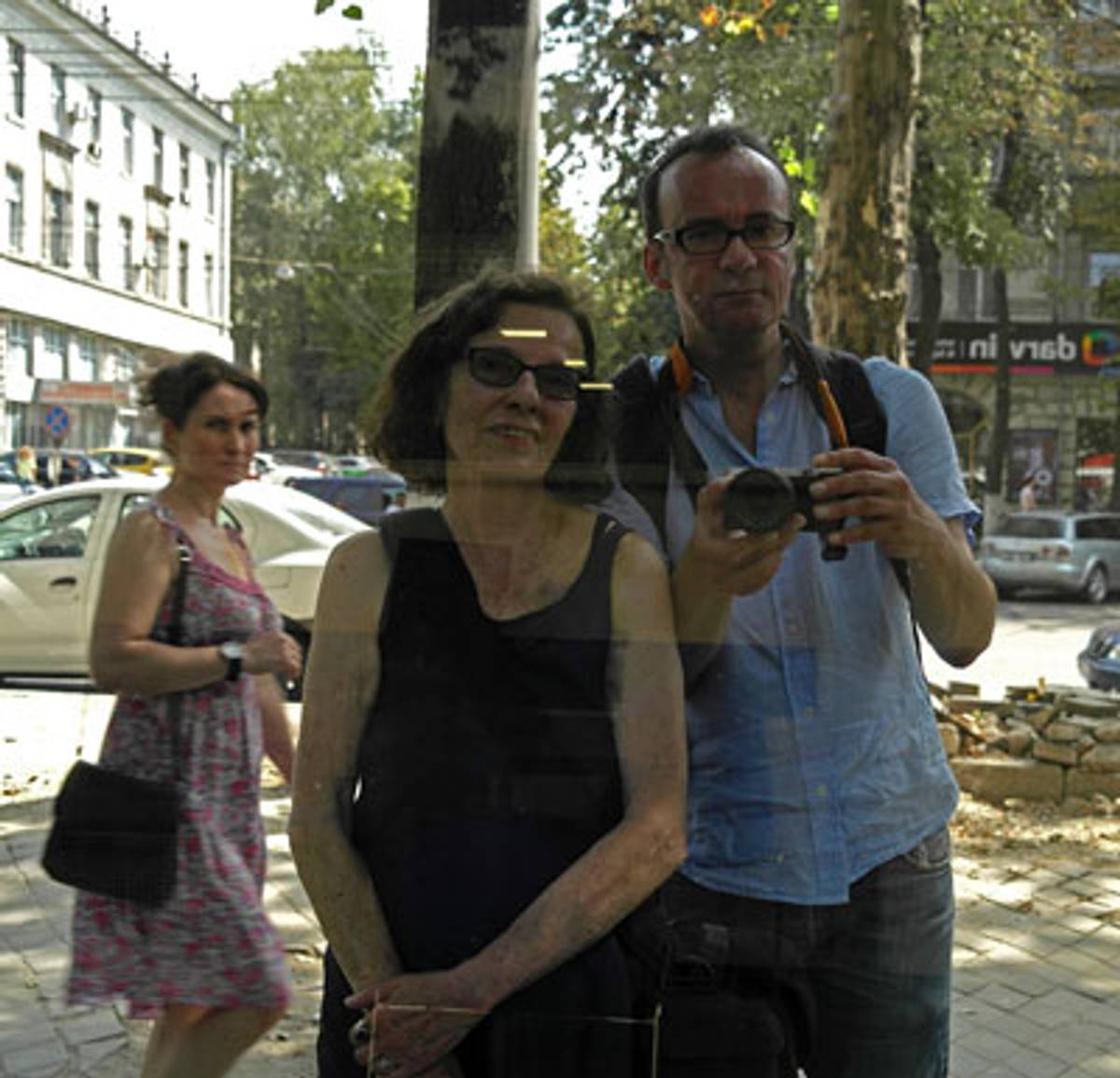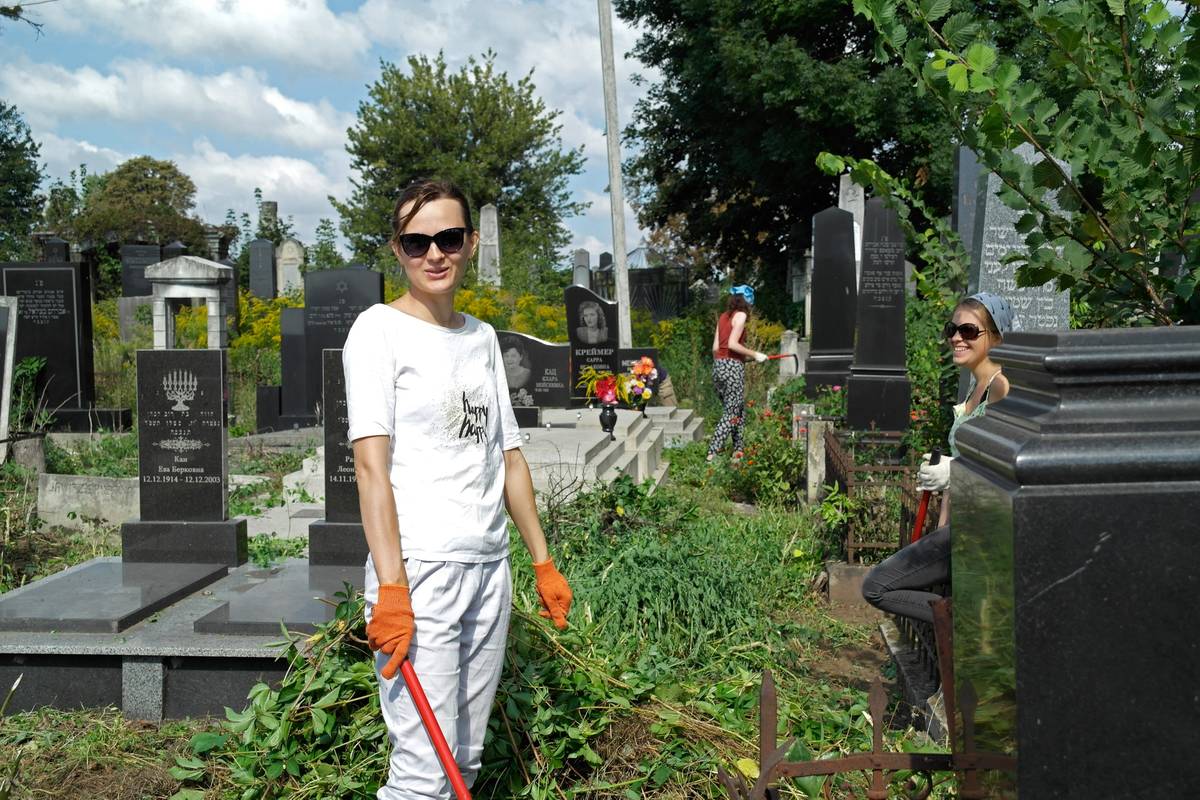Historic Cemeteries in Ruin
Jewish graveyards in Eastern Europe are crumbling, neglected, and vandalized. Who will be responsible for protecting them—and their communities’ history?




International Holocaust Remembrance Day, held annually on January 27 since it was designated by the United Nations in 2005, is typically marked with public events. But for many Jewish communities in Eastern Europe, the day is a painful reminder that historic Jewish cemeteries lie in states of ruin, ignored by local municipalities as well as the global Jewish community.
One man raising awareness about the issue is Christian Herrmann, creator of the travel blog “Vanished World,” which features impressions of historically important Jewish sites, mostly in Eastern Europe. He now works with members of the former Jewish community of Chernivtsi (Czernowitz) in Western Ukraine to organize volunteers who help clean and maintain the city’s Jewish cemetery. This effort is inspiring other cities in the region—but questions about who is accountable to fund these projects make progress an ongoing challenge.
The Chernivtsi cleanup project, which began in 2008, has its roots in Herrmann’s blog, which records his travels using a mix of artistic photography, historical tidbits, and personal impressions. Born in Germany in 1962, Herrmann admits his interest in Jewish culture is somewhat strange given his lack of Jewish roots. Although there were few Jews in the country during his youth, he befriended several members of the tribe and became curious about their culture in Eastern Europe. “I realized I knew how Jews had died in the Holocaust, but not how they lived,” he told me. “I became interested in what happens to a geographical region when a significant portion of the population disappears.”
In the late 1990s, with the Berlin Wall down, he embarked on his first trip to Ukraine. His visit created more questions than answers. When he’d inquire about a certain Jewish cemetery or site, he recalled, “People would say: ‘There never was a synagogue or cemetery here.’ In some cases, they really didn’t know due to the exchange of populations that happened over time. In other cases, there was a feeling of guilt, and even sometimes, a fear that the Jews would return and ask for their property back.” Over the last 20 years, however, Herrmann has seen increased efforts by locals to process the tragedy of the Holocaust.
The list of places he has written about on his blog reads a bit like an old atlas— Bessarabia, Transylvania, and Galicia, all historical regions once teeming with vibrant Jewish life and now occasionally visited by Jewish tourists seeking the burial places of their ancestors. His most avid readers fall into this category and look to him as a ray of hope in their search for pre-war roots.
But Herrmann offers his Jewish readers tough truths along with nostalgia. From visits on location, he describes crumbling and vandalized matzevas (Yiddish/Hebrew for tombstones), graves opened by thieves, and vegetation so dense it must be hacked through to walk in a straight line. For example, in a recent post from Chişinău (Kishinev), the capital of Moldova and the location of the notorious Kishinev Pogrom in 1903, Herrmann writes: “Chişinău’s Jewish cemetery is the most important witness of the city’s Jewish past. Unfortunately, it is in a miserable state—densely overgrown and with rubbish everywhere.”

Herrmann believes the restoration of such sites should be the shared responsibility of local municipalities, the families of Jews who lived there, and the countries responsible for the Holocaust, such as Germany and Romania. Unfortunately, none of these groups are fully participating, he says. Local governments in Ukraine are struggling to accept non-ethnic Ukrainians such as Armenians, Jews, and Germans into their narrative. Some among them believe the Jewish community should take sole charge of maintaining the sites. As for the Diaspora Jewish community, Hermann said drily: “Most of their involvement has been complaining.” Jewish tourists tend to come to such areas with a vague concept of finding the graves of their family members, but are often shocked to find crumbling sites. This shock does not usually turn into activism, he explains.
Chernivtsi is one exception to that rule. With its relatively large number of Holocaust survivors, it proved the right location for a joint project between Herrmann and the city’s former Jewish residents. He first visited in 2006, knowing little about the region beyond that many German-Jewish writers hailed form there. In time, he learned of the significance of this community. Starting in 1849, when the Austrians decided to separate the regions of Galicia and Bukovina, it had become a center for Jewish life, in which Jews were the elite of the city, serving as city officials, academics, and titans of business. This ended in the late 1930s when Romania took over and Jews were subjected to open, violent racism. But it was the city’s Romanian mayor Traian Popovici who pleaded for the lives of the city’s Jews during the Holocaust, explaining to the Nazi-controlled Romanian government that he could not afford to send all Jews to camps, as it would severely compromise the city’s basic functions. While many were sent to camps and killed, he was able to save some 20,000. Today, there are about 1,500 Jews living there.
After Herrmann’s visit to the city, he joined an online group for people concerned with its Jewish history and connected with Miriam Taylor, a lab technician from Indiana who left Chernivtsi (then called Cernauti) in 1945, after a traumatic wartime childhood. Herrmann learned of the group’s concern about the overgrown 12-hectare cemetery, which Taylor has described as “an impenetrable jungle.” The municipality was supposed to maintain the cemetery two days a week, but most of the local manpower went to caring for the Christian cemetery. In addition, some locals were seriously overcharging tourists to locate family graves.
Herrmann, who works for an umbrella organization of European volunteer groups, offered a list of several such groups to which the Czernovitzers might apply for help. Taylor chose SVIT Ukraine and Germany’s Action Reconciliation Service for Peace. The groups sent small delegations of volunteers in 2008 and 2009, respectively. At the same time, Taylor began working with the city council to get additional help with the heavier work, such as using power saws to cut large branches. According to Taylor, the first group of volunteers, composed mostly of college-age Europeans, were enthusiastic and enterprising, even rallying locals to help out with the cleanup. Herrmann accompanied the group and offered the young volunteers historical background about their surroundings. The cleanups (known colloquially as work camps) have gone on to become a tradition in the city. To date, SVIT Ukraine has held nine sessions, while Action Reconciliation Service for Peace has sent seven delegations.
Buoyed by the volunteers, Taylor helped form the Czernowitz Jewish Cemetery Restoration Organization and began to raise funds for bigger projects. An avid gardener, she procured herbicides and made sure they were used properly, so that less maintenance would be needed in the future. Although she used to be afraid to visit her native city, Taylor is now a regular in the area and has become an important figure in the lives of the volunteers. She has also made new friends throughout the city.

Even more notable is how the work has influenced the volunteers. Olga Antonova, 21, a student at Taras Shevchenko National University in Kiev, admits that before she joined the SVIT Ukraine group this past year, all she knew of Jews and their life in the Ukraine was “just some unpleasant stereotypes.” Between sorting branches, covering graves, and cleaning trash, Antonova says she enjoyed visiting the local synagogue on Shabbat and meeting members of the local Jewish community. She also connected with fellow volunteers from Europe and Japan, and loved the excursions organized by Herrmann, as well as the opportunity to meet Jewish people from around the world, including Taylor. “Finally, I broke my stereotypes about Jews and realized they are really nice people,” she said. “Although we may be different, we still have much in common.”
But the question remains whether the model of growth and change in Chernivtsi can be duplicated in other communities.
Irina Shikhova, a sixth-generation resident of Chişinău and curator at the Jewish cultural center who has guided Herrmann through the area’s sites, hopes for something similar in her city, but the situation is fraught with challenges. The local Jewish community is small—numbering about 5,000—financially limited, and faces difficulties working with unregulated local municipalities. An effort to improve the cemetery in the early 2000s failed for some of these reasons.
Chişinău was once home to two Jewish cemeteries; the older one was covered by concrete in the Soviet era and turned into a park and tennis court. One winter in the late 1950s, the Jewish community was given a few months to move the remains of those buried there, but Shikhova believes most of the remains are still there. The second cemetery, dating back only to the early 19th century, is the one she hopes to see improved with a volunteer crew. However, unlike in Chernivtsi, there are few members of the pre-war Jewish community alive and few of their descendants who are actively involved. The city provides limited maintenance: “They don’t touch graves at all, just the lines between the graves,” she said, so a few local Jewish families pay private companies to do some work.
Shikhova is now gearing up to work with the municipality, a job few want to take on. She says Jewish tourists come with “mythology” about the city, often expressing fear of visiting: “Look, we had a pogrom more than 110 years ago, but that’s what Kishinev is known for.” She is hopeful that with time the broader Jewish community will come to know the city’s contemporary life. “We are small. We are modest….but we are open to the world and looking forward to being part of the world Jewish community as brothers and sisters.”
It remains to be seen what the future will hold for cities like Chişinău, Chernivtsi, and others, but Taylor is hopeful that the global Jewish community will mobilize to help. “Besides for the obligation to maintain graves, there is cultural, economic and political history in graveyards,” she said. “I wish there was a general Jewish organization whose job it would be to do this.”
For now, few are passionate about the issue. Herrmann explains that collective trauma may lie at the root of the problem. For the second generation after the Holocaust, the prospect of dealing with the topic is often too emotionally difficult, while the third generation no longer cares, he said. He describes the experience of Jewish tourists who visit small towns and shtetls where no one has cared to maintain anything: “They come back with tears in their eyes and say, ‘How can this look like this?’ There is an expectation that someone should do something.”
***
Like this article? Sign up for our Daily Digest to get Tablet Magazine’s new content in your inbox each morning.
Suzanne Selengut writes feature stories about global Jewish issues and the arts. She is based in New York City.